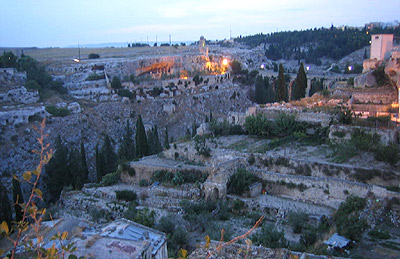GRAVINA
Gravina is situated on the
borders of Basilicata, in the Western Murgia area; a territory
with high Karst formation, characterised by the presence of
numerous grottos, which gave refuge since Neolithic times
(V millennium BC) to the local population who were devoted
to agriculture and sheep farming.
A permanent settlement developed on the Botromagno hills during
the Iron Age, which over the centuries from the 8th to the
5th centuries before Christ, were, like many other centres
in the region, gradually more influenced by Greek culture
imported from the colonies.
During this period it was known as Sidion when construction
of its defensive walls occurred. The City maintained, as testimony
of its importance, the right to mint its own currency (4th
Century BC).
In 305 BC, it was conquered by the Romans and included along
the Via Appia (Appian Way) route, and given the name of Silvium.
As with many other localities in the region after the Civil
Wars (90BC), it became a municipium, and Gravina enjoyed a
period of wealth and economic development during the Imperial
era.
The end of the Empire brought destruction by the Vandals,
commanded by Genserico in 456, whilst its inhabitants sought
refuge for centuries in the natural grottos in the area, giving
start to the so called Rupestrian Civilisation.
After the Greek-Gothic Wars (535-553), fought and won by the
Byzantines against the Ostrogoths, Gravina entered and remained
for centuries under the Western Roman Empire of Constantinople,
therefore suffering invasions and plunder by the Saracens
(999).
The Norman arrival in the City coincided with its cultural
and economic rebirth, which manifested in the construction
of the new Cathedral in a Romanesque style and Palazzo Vescovile
(Episcopal Building – 11th Century).
With the subsequent advent of the Swabians (1194), Gravina
acquired major importance in the territory and became a Curia
Generale (Episcopal Administration) for the whole of Puglia
and Basilicata. Federick II ordered construction of the Castle,
which today, one can visit what remains of the building.
Gravina became a state and feudal City after the end of Swabian
rule by the hand of the Angioini (1266), who were called by
the Pope to Italy. It was subsequently entrusted to the Orsini
Family, who ruled it continuously from 1380 to 1816.
From the 19th Century, Gravina adhered to the Renaissance
process, which brought it to the idea of a national state
through the Carbonari (An association which promoted independent
ideas) clashes of 1820 and the revolts of 1848. In 1861, along
with all of Puglia, the City passed over to the Reign of Italy.
Gravina has a rich testimony of artistic architecture, beginning
with its Cathedral and nearby Palazzo Vescovile (Episcopal
Building – 11th-12th Centuries).
Among the other churches worth mentioning: S. Domenico, S.
Lucia, the Madonna of the Grazie Sanctuary and the churches
and convents of S. Sofia and S. Sebastiano (1474).
Incredibly from the ancient history of the City, one can still
admire an intact Roman bridge.
Every year in April, the City hosts the San Giorgio Feast;
one of the oldest manifestations in the world, being instituted
by royal decree of Carlo II of Angiò in 1924. This
decree by Carlo, in turn, only re-established a ancient feast.
|
